Body length: 9–26 mm.
Eyes: eye interommatidial setaeseta:
a sclerotized hair-like projection of the cuticle
absent, eye deeply emarginateemarginate:
notched at the margin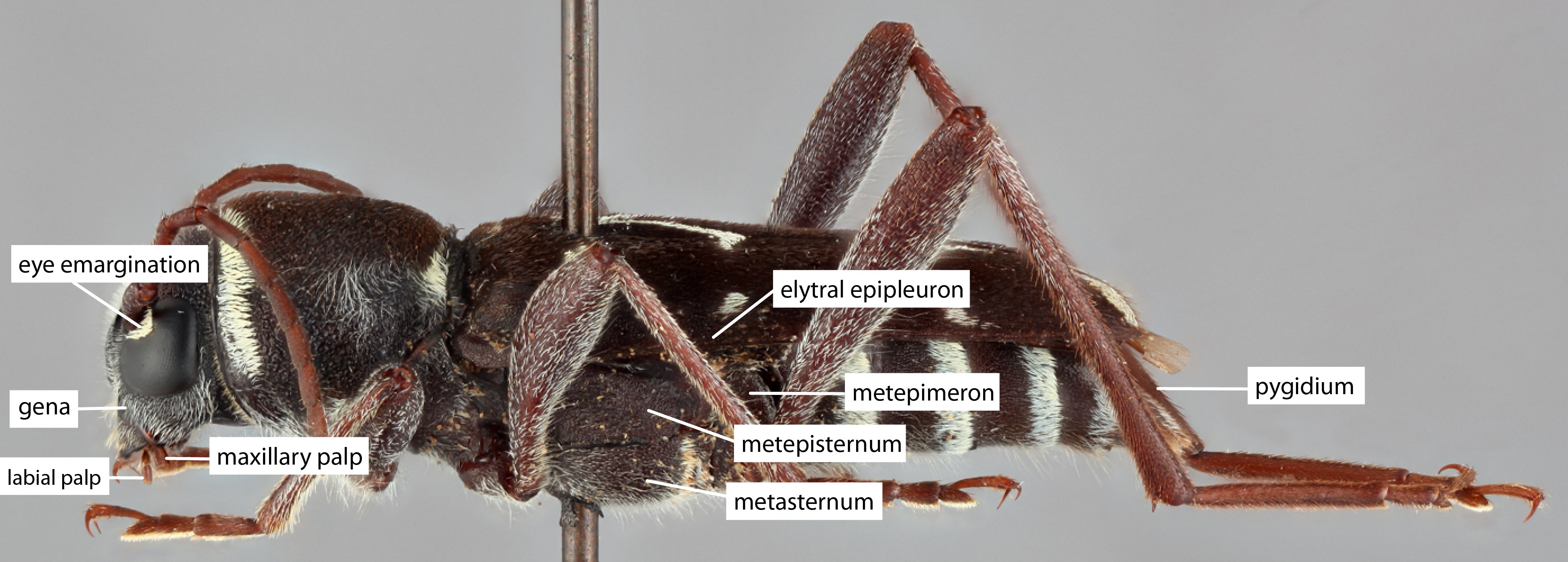 > half width, eye ommatidial density coarse.
> half width, eye ommatidial density coarse.
Antennaeantenna:
in larval and adult insects, paired segmented appendages, borne one on each side of the head, functioning as sense organs and bearing a large number of sensilla
: antennal length reaches between basebase:
the part of any appendage or structure that is nearest the body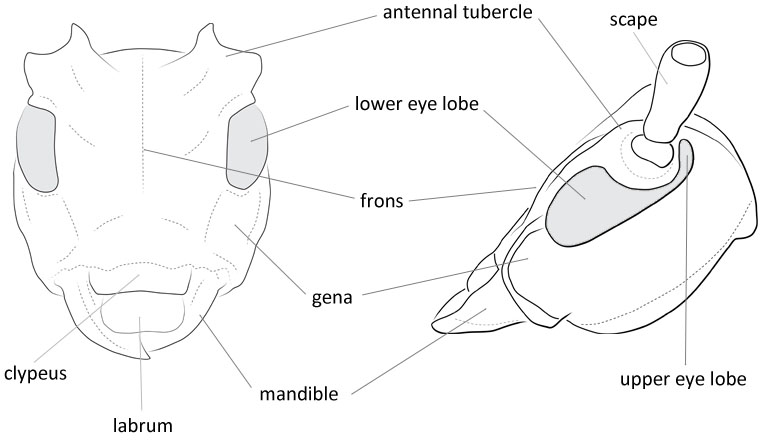 and end of elytraelytron:
and end of elytraelytron:
the leathery forewing of beetles, serving as a covering for the hind wings, commonly meeting opposite elytron in a straight line down the middle of the dorsum in repose
or reaching/surpassing end of body, antennal flagellar segments elongateelongate:
much longer than wide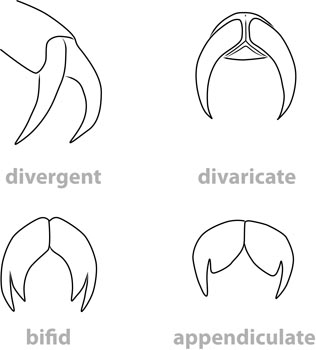 , scapescape:
, scapescape:
the first proximal segment of the antenna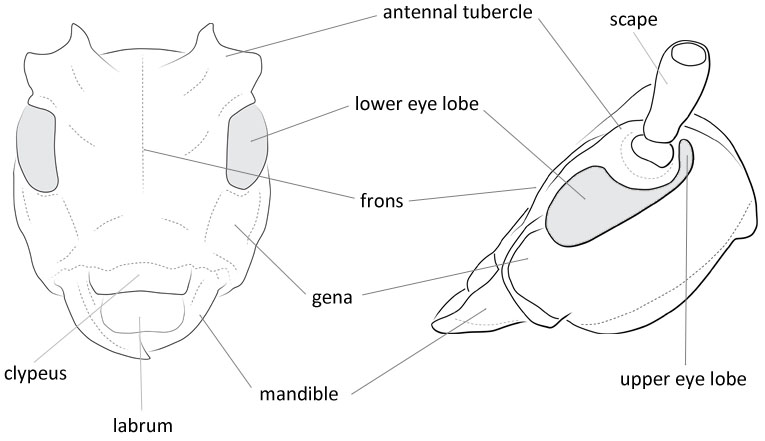 smooth/punctate at apexapex:
smooth/punctate at apexapex:
end of any structure distad to the base , antennal segment 3 > scapescape:
, antennal segment 3 > scapescape:
the first proximal segment of the antenna .
.
Pronotumpronotum:
the upper and dorsal part of the prothorax : pronotumpronotum:
: pronotumpronotum:
the upper and dorsal part of the prothorax shape transversetransverse:
shape transversetransverse:
broader than long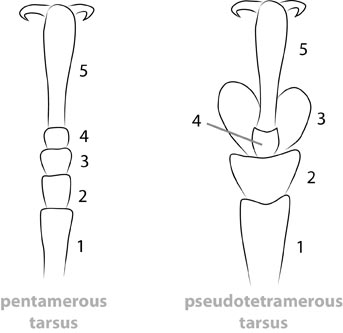 , pronotumpronotum:
, pronotumpronotum:
the upper and dorsal part of the prothorax lateral armature acute spinespine:
lateral armature acute spinespine:
a protuberance with an acute (sharp) distal end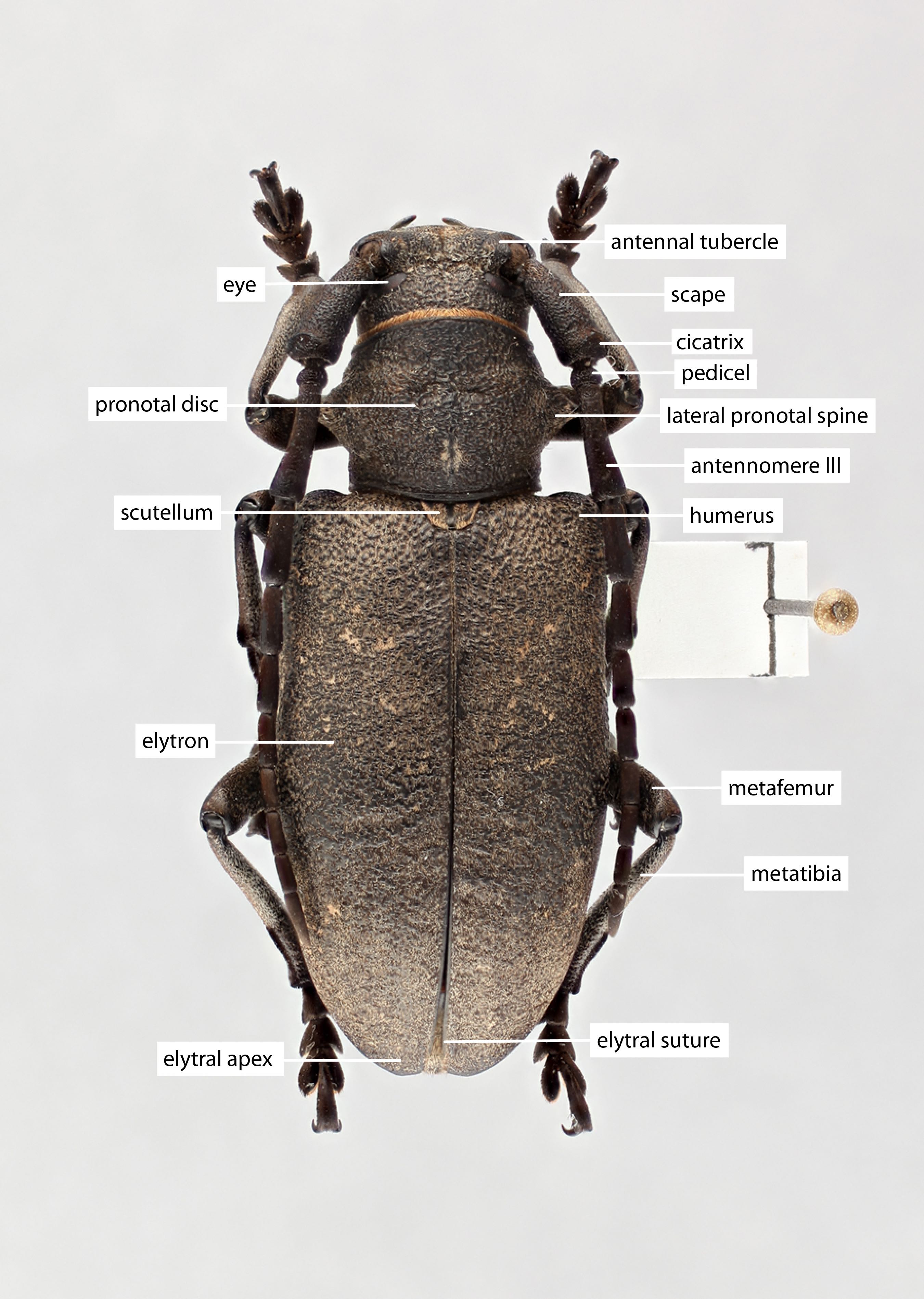 .
.
Prosternum: prosternal processprosternal process:
a posterior extension of the prosternum between the coxae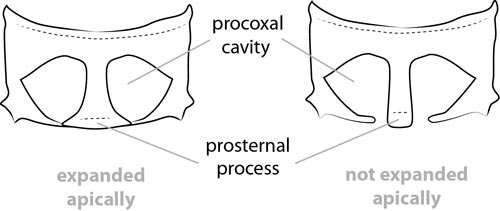 dilated at apexapex:
dilated at apexapex:
end of any structure distad to the base , procoxal cavities closed posteriorly.
, procoxal cavities closed posteriorly.
Elytraelytron:
the leathery forewing of beetles, serving as a covering for the hind wings, commonly meeting opposite elytron in a straight line down the middle of the dorsum in repose
: elytral length reaching or close to end of abdomen, elytral apicesapex:
end of any structure distad to the base
rounded or truncatetruncate:
cut off squarely at the tip , emarginateemarginate:
, emarginateemarginate:
notched at the margin or with tooth or spinespine:
or with tooth or spinespine:
a protuberance with an acute (sharp) distal end , elytral color black, brown or reddish, elytral color pattern present or absent.
, elytral color black, brown or reddish, elytral color pattern present or absent.
Legs: visible tarsomerestarsomere:
subdivision or article of the tarsus, usually numbering from two to five : 4, femora clavateclavate:
: 4, femora clavateclavate:
thickening gradually toward the tip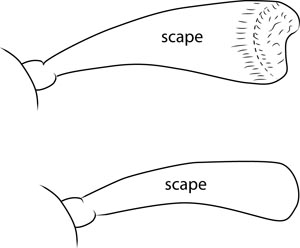 , protibial spursprotibial spur:
, protibial spursprotibial spur:
sclerotized spine(s) located at the distal tibia; can be single, double, or absent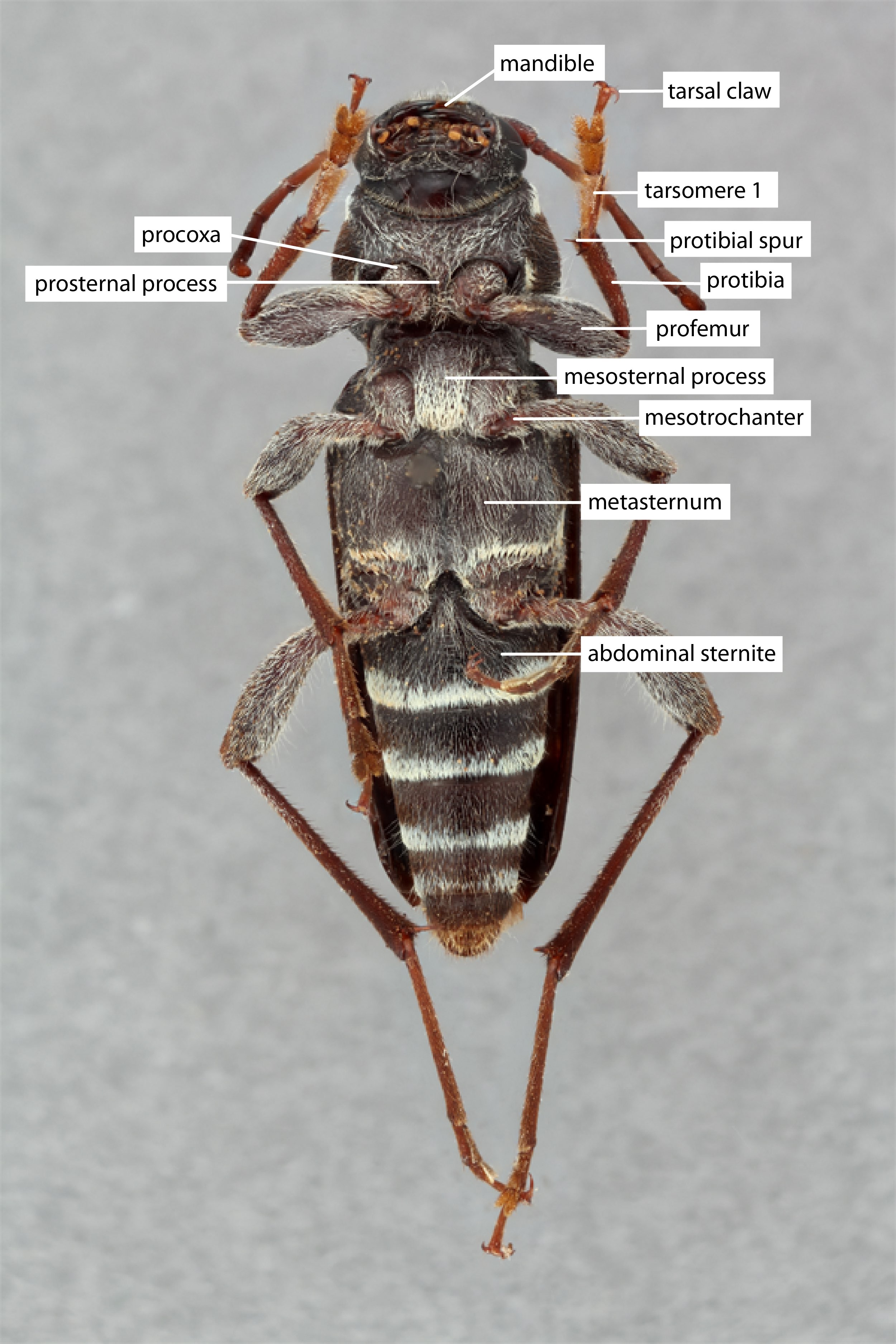 : 2, tarsal clawstarsal claw:
: 2, tarsal clawstarsal claw:
usually paired claws of the pretarsus, at the distal end of the leg simple.
simple.
Form moderate-sized to large, tapering posteriorly. Head with front rectangular, plane to feebly convex; median line narrow, extending onto neck; genaegena:
the part of the cranium on each side below the eye elongate, subparallel to convergent; mandibles arcuatearcuate:
elongate, subparallel to convergent; mandibles arcuatearcuate:
arched or bow-like , acute at apicesapex:
, acute at apicesapex:
end of any structure distad to the base
; palpi unequal, slender; eyes rather finely faceted, deeply emarginateemarginate:
notched at the margin , lobes narrowly connected; antennaeantenna:
, lobes narrowly connected; antennaeantenna:
in larval and adult insects, paired segmented appendages, borne one on each side of the head, functioning as sense organs and bearing a large number of sensilla
slightly longer than body in males, about as long in females, third segment longer than scapescape:
the first proximal segment of the antenna , segments lightly fringed beneath. Pronotumpronotum:
, segments lightly fringed beneath. Pronotumpronotum:
the upper and dorsal part of the prothorax broader than long, sides prominently, acutely tuberculate; disk with two large, elevated calluses, middle with a rounded or linear callus; prosternum excavated before coxae, coxal cavities rounded externally; mesosternummesosternum:
broader than long, sides prominently, acutely tuberculate; disk with two large, elevated calluses, middle with a rounded or linear callus; prosternum excavated before coxae, coxal cavities rounded externally; mesosternummesosternum:
sternum of the mesothorax
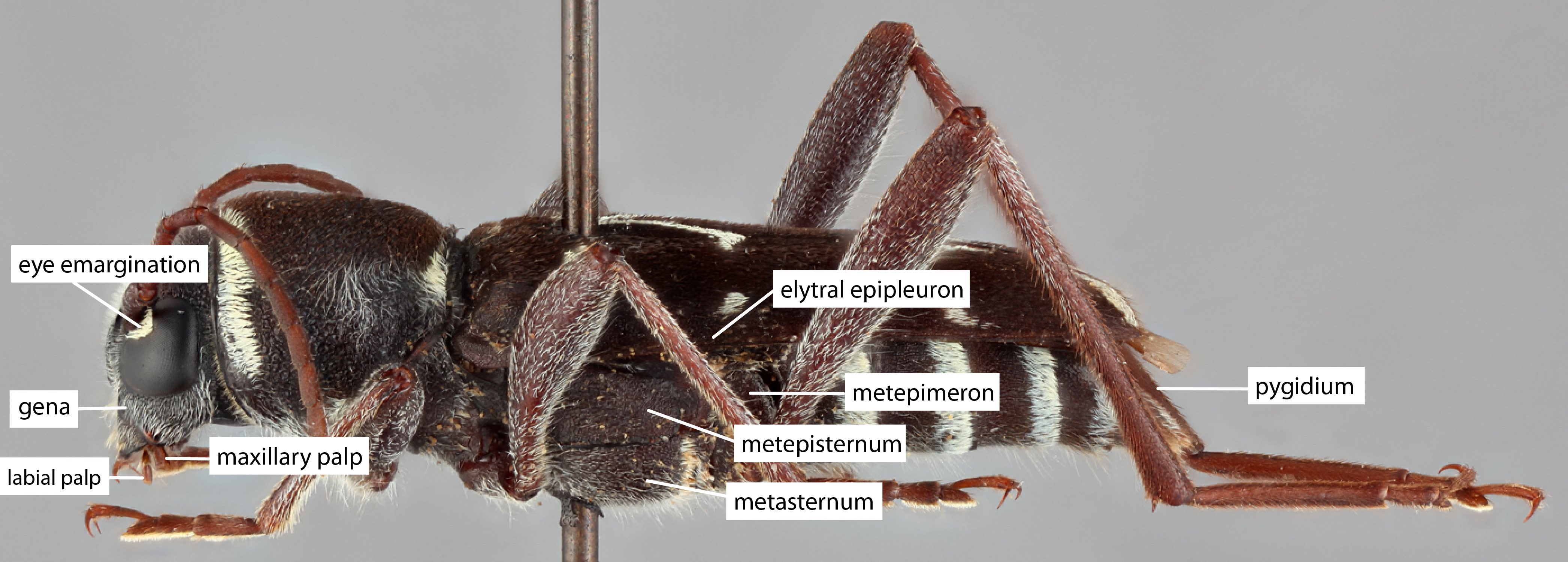 with intercoxal process arcuatearcuate:
with intercoxal process arcuatearcuate:
arched or bow-like or declivous. Elytraelytron:
or declivous. Elytraelytron:
the leathery forewing of beetles, serving as a covering for the hind wings, commonly meeting opposite elytron in a straight line down the middle of the dorsum in repose
less than twice as long as broad; basebase:
the part of any appendage or structure that is nearest the body feebly to strongly gibbose on each side; apicesapex:
feebly to strongly gibbose on each side; apicesapex:
end of any structure distad to the base
emarginate truncatetruncate:
cut off squarely at the tip , outer angle often dentate. Legs stout, femora clavateclavate:
, outer angle often dentate. Legs stout, femora clavateclavate:
thickening gradually toward the tip ; front tarsitarsus:
; front tarsitarsus:
the leg segment distal to the apex of the tibia, bearing the pretarsus; consists of one to five tarsomeres (including pretarsus)
of males broad, fringed laterally. Abdomen with last sternite linearly impressed in females (Linsley and Chemsak 1985).
Acanthoderes, Scythropopsis, Symperasmus
The characters to differentiate Aegomorphus from close Acanthoderini are coarsely granulategranulate:
minutely and densely verrucose or minutely farinose
eyes, and a pronotumpronotum:
the upper and dorsal part of the prothorax
without a central depression or lateral tubercles forming carinacarina:
an elevated ridge or keel, not necessarily high or acute
.
Nearctic, Palearctic, Neotropical
broadleaf trees
95 species. According to Craighead (1923)Craighead (1923):
Craighead FC. 1923. North American Cerambycid Larvae. A classification and the biology of North American cerambycid larvae. Bulletin of the Canada Department of Agriculture (n.s.) 27: 1–239, figs 1–8, pls 1–44., the Nearctic species of Aegomorphus, except A. morrisi, are deadwood feeders in hardwoods which have reach a certain stage of decay. The wood must be soft and pulpy, usually decomposed by fungi. The larval mines are extended between the bark and wood and are not very extensive. The pupal cell is shallow and constructed in the outer sapwood. This is indicated by a protruding wad of coarse, fibrous frassfrass:
solid larval insect excrement
.
Psapharochrus Thomson, 1864Thomson, 1864:
Thomson J. 1864–65. Systema cerambycidarum ou exposé de tous les genres compris dans la famille des célrambycides et familles limitrophes. H. Dessain, Liége, 578 pp. [1864: pp. 1–352; 1865: 353–578; Also published in Mémoires de la Société Royale des Sciences de Liége 19 [1866]: 1–578].
Aethiopoctines Thomson, 1868
Aegomorphus Haldeman, 1847